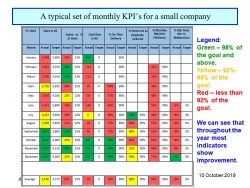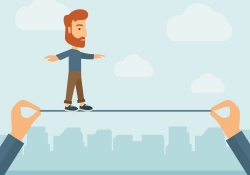Covid-19 changed many things in one fell swoop.
One of those is the prohibition on face-to-face meetings. With the meetings we were used to no longer possible, we started using Zoom or similar softwares.
School and university lectures, management meetings, consultations, workshops, coaching sessions.
A related change occurred in the sphere of work. The proximity of many people in small spaces at work became a problem in itself.
Factories and traditional industries can't operate machines remotely, but as part of the initial pandemic wave, many managers chose to temporarily and partially shut down production. In Israel, as the first wave passed, factories reopened, while taking precautions.
Anyone who could, sent employees to work from home.
Essentially we have here three subjects:
- Meetings of any kind. Studies, workshops, meetings.
- Work from home.
- Closing the circuit, the connection between the two and the damage companies could suffer due to remote work.
Let's start with the first.
Meetings, Workshops, School, and Coaching Sessions over Zoom
At first it seemed strange. Those of us who were used to study and teach, coach or guide face to face, had a difficult time adjusting.
For those not used to it, the idea of holding meetings over Zoom was hard to take.
The coaching community of which I'm a part saw many discussions of the change – how to handle it, what the advantages are.
Like any change, this too seemed threatening at first.
But most of us adjusted quickly. The ability to hold meetings, workshops, sessions, all without leaving home, became a benefit. No need to waste time on traveling from place to place.
Some people don't turn their cameras on. Very comfortable. You're at a meeting, but don’t really have to pay attention.
And that's not all. You can join lectures, webinars, or members meetings, without having to give your full attention. That is, only half listen, while simultaneously doing something else.
It seems the new situation is so good, there's no going back.
Is It Really So Good?
I lead teams as part of the Hoffman-Kofman Leadership Program, and due to Covid-19 limitations, they take place over Zoom. But the participants yearn to also meet face to face, so we've included some "real world" meetings.
From the start, we gave the face-to-face meetings more time, devoted to personal connections. But when that extra time was over, late in the evening, participants had a hard time saying goodbye. Suddenly we were back to what was once obvious. To see people, not just faces, to hear, smell, feel a person's energy.
It's possible to participate and hold a serious discussion over Zoom, but it still isn’t the same as face to face meetings. The personal connection, the intimacy, body language (as opposed to "face language" over Zoom), smiles, affection, or alternatively, discomfort or even anger - those don’t "pass" over Zoom.
Similar impressions I hear from other people too. Slowly, voices emerge, pointing out what we lost when we went fully remote.
We are social creatures, and direct personal connection is essential to us. Physical meetings even more so.
But Even before the Current Pandemic We Had Conference Calls with Companies Overseas
Yes, you can have conference calls with companies overseas. Technology makes that possible. But they lack the personal touch.
Videoconferencing, Zoom, and similar solutions, are possible when necessary, but aren’t the best option.
Most of my work consulting to companies happens on site. It's possible to brainstorm over Zoom, but it would be near impossible to have an improvement-team meeting over Zoom.
When working with manufacturing companies, I can't severe my connection to the production floor, to conversations with employees, to what I see and hear.
I can work remotely with managers, but my contribution won't be meaningful if I don’t have a personal connection with employees on the production floor.
When I lead workshops, I combine Zoom. Due to lockdowns and Covid-19 restrictions, it often happens that at least one participant is limited to using Zoom, sometimes with the camera turned off.
As I wrote above, it's very easy to pay only limited attention when remote. To do something else at the same time – answer texts, eat, surf the web. Above I presented it as "an advantage" for participants, but as far as achieving the meeting's goals, that's of course a downside. Participants aren't fully engaged, aren't "in the here and now", and that leads to lower quality results.
And What about Sales Meetings?
Online sales are a necessity. We're all getting more and more comfortable with online shopping, and so businesses must adjust, and have a suitable sales process.
But such sales have a passive element. That is, we wait for someone to enter our online store. We don’t initiate meetings with clients.
You can and should create a "sales funnel", to generate the biggest possible crowd, and in this context this means having a good online store, or an excellent landing page. But two things are missing: the personal connection, and the ability to reach a specific person and present the product's advantages. Even in the age of online shopping, there is value to personal relationships, especially when selling to businesses (B2B).
Summary - Meetings, Workshops, School, and Coaching Sessions over Zoom
You can hold any meeting of any type over Zoom, or similar technologies. But, compared to face to face meetings, we lose a lot.
When I give lectures, a lot of energy flows both ways. I can immediately feel if a connection has been established.
During physical meetings, we see and read body language. We can see if our conversation partners are fidgeting, when they're listening and when they're not. Who's busy with a smartphone, etc. The fact we can have meetings over Zoom, doesn’t mean we should, unless we must.
Let's Move to Work-From-Home, and Start with Three Examples
All of these examples are real, though names have been removed.
- A., the CEO of a small startup I worked with, said that during the lockdown, when everybody worked from home, he got a lot more done, because he didn’t "waste" time on small-talk and watercooler chats.
But those chats and running into his employees are very important to him, he said.
It's an opportunity for him to forge personal relationships with his employees, to listen to them and pay attention. And so, when the company resumed on-site work, he wasn’t sure how to proceed, and eventually decided to take one day a week to work remotely, and work form the office the rest of the time. - G. is a programmer at a tech company which has gone fully remote. In our talks, G. described the new situation as frustrating and regretable. The change to "sterile" work and the loss of personal connection with the other employees weighed heavily on him.
- D. is a good friend of mine, and works as an engineer at Intel. When the pandemic hit, Intel continued production, but all those who could switched to remote work. Unlike G., D. enjoys the new routine. Working from home, "in her pajamas", agrees with her. She told me she gets a lot more done, and that her conversations with her American collogues have become more personal, as a result of the shared anxiety over Covid-19. Those conversations, by the way, happen with all cameras turned off, so no one has to dress up.
Since schools were closed and D.'s kids were home, Intel payed for a sitter.
To summarize these three examples, we have an adult engineer at Intel who likes remote work, a young programmer who finds that same situation frustrating, and a CEO who understands how remote work can lead to higher production while also damaging the personal connection with employees.
What Can We Learn from Microsoft's Research on Remote Work?
A short web search led me to research conducted by Microsoft, on the effect working from home had on its employees. The results were published in the Harvard Business Review (this article is behind a paywall. For a free report on it, go here).
The research found that the move to flex time and remote work saw more and more employees preferring to work evenings. The company's instant messaging software saw a 50% rise in communications between 18:00 and 24:00.
Since there were no more casual breakroom interactions or watercooler chats, there was a 10% increase in the number of weekly meetings.
Meetings became shorter. There was a 22% increase in short meetings (less than 30 minutes), and an 11% decrease in long meetings (over an hour).
Managers tried to stay in contact with their employees, and had more one-on-one meetings with them.
For their part, employees tried to compensate for the loss of direct personal connections by having more conversations, and more casually, in an attempt to preserve interpersonal relationships.
More on This in The Marker
Israeli journal The Marker published an article by Ronit Domka, where she discusses a similar research , which examined 3.1 million employees, at 21,000 companies, in 16 global cities.
It found that employees working from home added an average 48.5 minutes to their workday, meetings increased by 13%, and internal email volume by an average 40%.
So far for statistics. What about experiences? Researchers described remote work as double edged. On the one hand, flexibility, which allowed employees to adjust their workday to suit family time and chores, empowered employees. On the other, this also created a blurring between work and home life, which could lead to overworking because of the lack of separation between home and office. However, they estimated that over time, newly remote employees will find that balance again.
And What Are the Costs for Companies and Employees?
The The Marker article goes on to present statistics of companies who intended to continue remote work after the pandemic. If remote work, then why not switch to contractors and freelancers?
I think it's time to leave the statistics, and move from the macro to micro level. To look at employees and their connection to each other and to the company.
A., the CEO from the first above example, provided a good description of the difficulties inherent in remote work: the lack of personal connections between management and employees, and amongst the employees themselves.
Now days, it's clear that companies striving for greater success, and for a competitive advantage, must have employees who are engaged and invested in company goals. This can be encouraged in many ways, and they all start with the routine "meetings" between employee and company.
The more remote work becomes the norm, the more the connection employees feel to their company disintegrates.
All the more so when working with sub-contractors: this creates a disconnect between the company, and the people working for it. In such a situation, people aren’t motivated to go the extra mile. I believe we'll see a developing gap between companies which will know how to keep employees invested, and those which treat employees like machines and easily exchangeable cogs.
People Need Personal Connections
As I wrote above, we are social creatures and have been dependent on our communities since the days of hunter-gatherers. This need hasn’t disappeared.
The need for personal connections is also mentioned in the two articles quoted above: employees look for different ways to maintain relationships (for example, "joint" remote lunches, "meet my pet", or similar ideas), and send more emails (which researchers explain as an attempt to maintain relationships and as long distances "talks").
As we can now identify a desire to go back to face-to-face meetings – so will employees seek personal connections. The longer people work remotely, and without these connections, the more we'll get used to it, and stop looking for connections in the work place. When this happens, there will be a disconnect between the company and its goals, and employees.
Summary and Recommendations
The necessity of social distancing brought about by the Coronavirus has changed the ways we act.
Meetings of all kinds – from lectures to one-on-ones – have gone virtual.
Companies sent all those who are able, to work from home, and in some companies that means all employees.
We're beginning to see that Zoom meetings and remote work can't fully replace physical meetings. They lack the exchange of energy between meeting participants, body language and personal connections.
If remote work continues for long, employees will lose their connection with the company, and will become less engaged and invested.
Eventually, they'll see that attempts to replicate personal connections virtually can't be enough, and will stop trying to maintain such connections at work. As a result, their investment in the company's success and in its goals will weaken further.
I suggest you do what ever is possible to hold face-to-face meetings, and bring employees back from remote work. At least partially.
Survey
Based on your experience and in your opinion – does the social distance in meetings and work damage company goals?
- The new situation has many benefits and we should continue this way.
- It is against human nature and hurts employees.
- We must find the way to return to the pre-Corona situation.
- Both ways have benefits, and we should combine them.
Focused and Fast Coaching and Consulting Services for CEOs and Companies during the Coronavirus Crisis
The Business Excellence team can help you build, within 2-4 working days, a plan to survive this financial crisis, or to achieve your goals.
We can help you to do the following:
Build a plan to handle this crisis, and couch you through it.
Identify possible threats to your company and come up with a plan to approach them.
Implement and manage work-from-home practices.
Identify and maximize the opportunities (!) presented by the crisis.
Our experts have a wide and diverse experience of over 100 years combined managing companies and consulting to CEOs – so we will be able to identify the unique needs of each companies, and find the safest and fastest way for you to approach the new challenges presented by the crisis, and to ensure your company's resilience.
If you are interested in my professional help, personally or for your company, the best way to contact me is to send a request through the Get in Touch form here.












 My First Book: Manage! Best Value Practices for Effective Management
My First Book: Manage! Best Value Practices for Effective Management